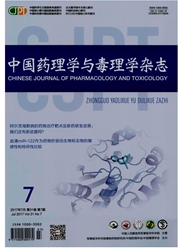

 中文摘要:
中文摘要:
目的评价氯胺酮的线粒体毒性,从而探讨氯胺酮可能的毒性机制。方法 Hep G2细胞培养基中分别加入齐多夫定10~2000μmol·L-1培养7 d,或加入氯胺酮50~3000μmol·L-1培养24 h,CCK8细胞计数法测定细胞存活率。Hep G2细胞培养基中分别加入齐多夫定100μmol·L-1培养7 d后,或加入氯胺酮100和1200μmol·L-1培养24 h,化学发光法检测胞内ATP合成水平,荧光探针法检测胞内钙离子浓度、活性氧及线粒体膜电位(ΔΨm)的变化,同时设齐多夫定1000μmol·L-1用于实时荧光定量PCR检测线粒体DNA(mt DNA)表达水平的变化。结果与正常对照组相比,齐多夫定10~2000μmol·L-1可以抑制细胞存活,IC50为100μmol·L-1;氯胺酮1000~3000μmol·L-1抑制细胞存活,IC50为1200μmol·L-1。与正常对照组相比,齐多夫定100μmol·L-1组线粒体ATP合成水平显著下降(P〈0.05),胞内钙离子浓度明显升高(P〈0.05),活性氧水平显著升高(P〈0.05),ΔΨm显著下降(P〈0.05),而1000μmol·L-1可以明显干扰mt DNA表达水平(P〈0.05)。氯胺酮100μmol·L-1组ATP合成水平明显下降(P〈0.05),其他指标均无显著性差异;氯胺酮1200μmol·L-1组ATP合成水平显著下降(P〈0.01),活性氧水平和胞内钙离子浓度显著升高(P〈0.01),ΔΨm显著下降(P〈0.05),mt DNA水平无明显改变。结论氯胺酮可以通过干扰线粒体代谢功能而诱导线粒体损伤。
 英文摘要:
英文摘要:
OBJECTIVE To evaluate the potential mitochondrial toxicity of ketamine and to explore its mechanisms. METHODS Hep G2 cells were cultured in zidovudine( AZT) 10- 2000 μmol·L- 1for 7d or ketamine 50- 3000 μmol·L- 1for 24 h. The cell viability was assessed by CCK8 assay. Hep G2 cells were cultured with AZT 100 μmol·L- 1for 7 d or ketamine 100 and 1200 μmol·L- 1for 24 h. The levels of cellular ATP were detected by luciferase assay. The levels of reactive oxygen species( ROS),intracellular free Ca2 +,and mitochondrial membrane potential( Δψm) were determined by flow cytometry.Hep G2 cells were cultured with AZT 100 and 1000 μmol·L- 1for 7 d or ketamine 100 and 1200 μmol·L- 1for 24 h while the content of mt DNA was quantified by RT-PCR. RESULTS Compared with normal group,AZT at 10- 2000 μmol·L- 1markedly inhibited cell viability( IC50= 100 μmol·L- 1),so did ketamine at 1000- 3000 μmol·L- 1( IC50= 1200 μmol·L- 1). After AZT 100 μmol·L- 1treatment,compared with normal Hep G2 cells,ATP levels were significantly decreased( P 0. 05) while the level of ROS and intracellular free Ca2 +significantly increased( P 0. 05). Δψmobviously decreased,but no significant changes in mt DNA content were observed,although a 0. 6-fold decrease in mt DNA content was observed at the concentration of AZT 1000 μmol·L- 1( P 0. 05). Ketamine 100 μmol·L- 1significantly decreased cellular ATP levels( P 0. 05),but there was no significant difference in other parameters.Ketamine 1200 μmol·L- 1significantly decreased cellular ATP levels( P 0. 01),but significantly increased ROS levels( P 0. 01) and intracellular Ca2 +levels( P 0. 01) while significantly decreasingΔψm( P 0. 05). No change in mt DNA content was observed. CONCLUSION Ketamine can induce mitochondrial toxicity by interfering with mitochondrial metabolism.
 同期刊论文项目
同期刊论文项目
 同项目期刊论文
同项目期刊论文
 期刊信息
期刊信息
